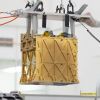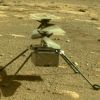-
 +21 +2
+21 +2Extremophiles on Mars could survive for hundreds of millions of years
One of Earth's toughest microbes could survive on Mars, lying dormant beneath the surface, for 280 million years, new research has shown. The findings increase the probability that microbial life could still exist on the Red Planet. Deinococcus radiodurans, nicknamed "Conan the Bacterium," is one of the world's toughest microbes, capable of surviving in radiation strong enough to kill any other known life-form. Experiments have now shown that if Conan the Bacterium or a similar microbe existed on Mars, it could survive 33 feet (10 meters) beneath the surface, frozen and dried out, for 280 million years.
-
 +2 +1
+2 +1Microbes may have survived for millions of years beneath the Martian surface
Ancient bacteria might be sleeping beneath the surface of Mars, where it has been shielded from the harsh radiation of space for millions of years, according to new research.
-
 +26 +11
+26 +11Elon Musk dreams of dying on Mars—now he might be one of the pioneering colonists
Before SpaceX’s Starship has even completed its first orbital flight successfully, Elon Musk is already dreaming of joining its maiden voyage to Mars. Once his youngest children are more grown up, the visionary CEO can imagine participating in a colonizing mission to the red planet, he told the Financial Times.
-
 +3 +1
+3 +1India’s Groundbreaking Mars Mission Is Officially Dead
But it leaves behind a long-lasting legacy after its eight years in space.
-
 +25 +5
+25 +5New evidence for liquid water on Mars suggests the planet is geothermally active
"Mars must still be geothermally active in order to keep the water beneath the ice cap liquid."
-
 +18 +1
+18 +1NASA Refines Its Strategy for Getting Humans to Mars
The updated “Moon to Mars” blueprint involves 63 high-level objectives that could finally bring the Red Planet within reach.
-
 +25 +4
+25 +4Mars is littered with 15,694 pounds of human trash from 50 years of robotic exploration
Discarded pieces of landing gear, crashed spacecraft and wear and tear have produced a lot of debris that is now scattered around the Martian surface.
-
 +20 +2
+20 +2How the Atom Can Split Martian Travel Time
Once in Earth’s orbit, you’re about 95 percent of the way to anywhere else in the solar system. But as with anything, that last 5 percent is an enormous challenge. To fill the gap, in today’s “New Space” era, engineers are dusting off a decidedly old-space idea: Nuclear Rockets. Indeed, Nuclear Thermal Propulsion offers a compelling means of making travel to Mars and other far-flung destinations faster, cheaper, and safer.
-
 +26 +4
+26 +4NASA’s InSight hears its first meteoroid impacts on Mars
The Mars lander’s seismometer picked up vibrations and sounds from four impacts in the past two years, a development detailed in a study co-authored by Brown planetary scientist Ingrid Daubar.
-
 +10 +2
+10 +2NASA's New Gadget Creates Oxygen On Mars
Finally, NASA has come up with the news which could possibly be a stepping stone for human life on Mars. A device called MOXIE may help in sustaining human life by producing oxygen. NASA has been exploring Mars’s climate for the past few decades. They, along with SpaceX CEO Elon Musk, have hinted at the possibility of life on Mars.
-
 +13 +5
+13 +5'Historic' Mars Experiment Produces Oxygen at the Rate of 1 Earth Tree
When NASA's robotic Perseverance rover blasted off to Mars last year, it brought with it a small, golden box called MOXIE, for the Mars Oxygen In-Situ Resource Utilization Experiment. Since then, MOXIE has been making oxygen out of thin Martian air.
-
 +15 +2
+15 +2Designers from the UK have built a Martian house
Would you like to live in a Martian house on Earth? If you like to live in one, a Martian house — designed to withstand Mars' harsh climate — was recently introduced in the heart of Bristol, United Kingdom. The Martian house was conceived by artists Ella Good and Nicki Kent, who wanted to use Mars as a lens to focus on what we need and how we want to live on Earth.
-
 +19 +4
+19 +4NASA Mars Helicopter Pulls Off a Tiny Flight, Proves It's Still Airworthy After Vacation
Ingenuity is battling dust, freezing temperatures and low power, but it perseveres.
-
 +19 +6
+19 +6Curiosity Mars rover gets 50 per cent speed boost from software update
The navigation strategy of NASA's Curiosity rover means it has to stop frequently to check its position, but soon a software update will allow it to move almost continuously.
-
 +11 +2
+11 +2Perseverance spotted a mysterious object on Mars last month. It turned out to be the rover's own space litter.
NASA suspects spaghetti-like debris captured by Perseverance's cameras in July is shredded Dacron netting from gear that landed the rover on Mars.
-
 +19 +6
+19 +6What a decade of Curiosity has taught us about life on Mars
Ten years ago, engineers at NASA's Jet Propulsion Lab celebrated the successful landing of its fourth robot on Mars, The Curiosity rover. Now old enough to enter the fifth grade, the Curiosity rover was set on its mission in 2012 to determine whether the red planet could have ever supported life.
-
 +14 +1
+14 +1Researchers aim to turn Martian air, dirt and sunlight into iron
A team of researchers, led by Swinburne's Professor Akbar Rhamdhani, has published the first detailed study of its kind on metal production on another planet.
-
 +19 +3
+19 +3Curiosity celebrates 10 years on Mars
Mars is a world entirely populated by robots: Orbiters and landers from a half-dozen space agencies scout its wafer-thin atmosphere and stark surface to unveil a surprisingly active past. On the ground, a hardy six-wheeled rover named Curiosity observed its 10th anniversary on the Red Planet this summer. Dust-streaked and running on punctured wheels, it continues to explore a desiccated landscape of wind-chiseled mesas, isolated buttes, and swirling sands for relics of a warmer, wetter, perhaps habitable Mars.
-
 +14 +4
+14 +4Perseverance is Searching for the Perfect Landing Spot for the Upcoming Sample Return Mission
NASA’s car-sized Perseverance (Percy) Mars rover has been had at work carrying out its science campaign in Jezero Crater on the Red Planet, but it’s equally been busy scouting for sites for NASA’s planned Mars Sample Return (MSR) mission, which is a joint mission with the European Space Agency.
-
 +15 +2
+15 +2Motorless sailplane for exploring Mars soars like albatross
The huge success of the Mars helicopter Ingenuity has proven it’s possible to explore other planets from the air, and researchers are working on a variety of flying craft concepts for future planetary missions. To fill in our knowledge of Mars between rovers on the surface and orbiters in space, researchers from the University of Arizona have proposed an experimental sailplane that operates without a motor and that could sail through the Martian air for days at a time.
Submit a link
Start a discussion




















